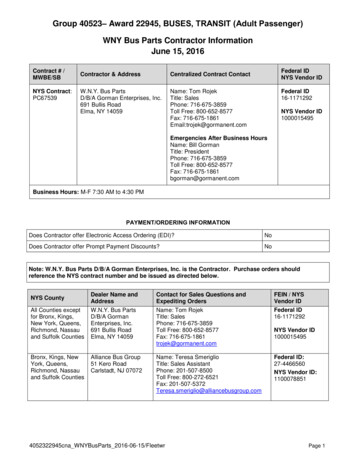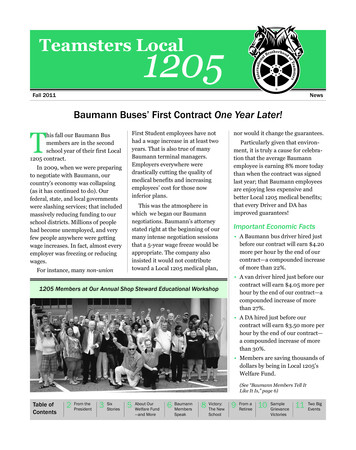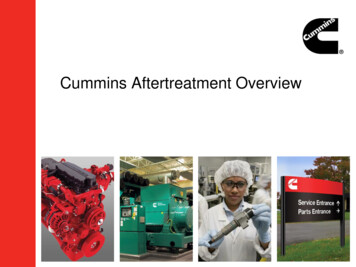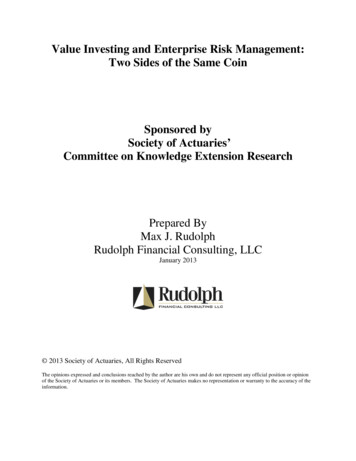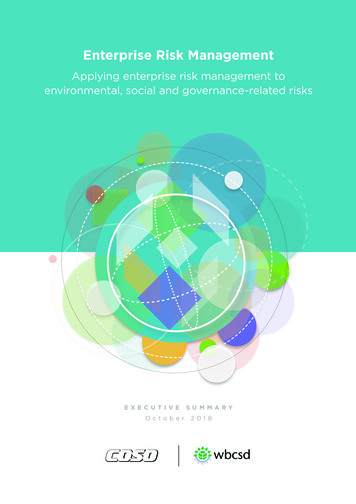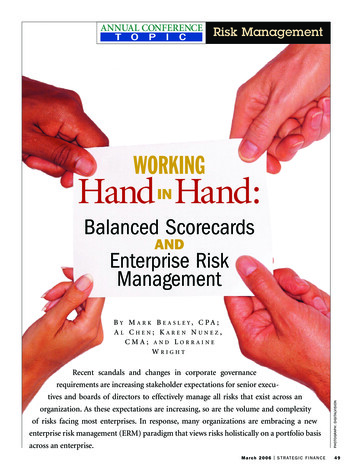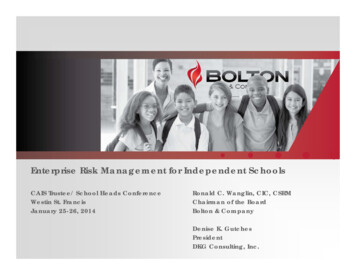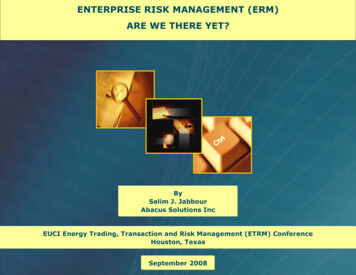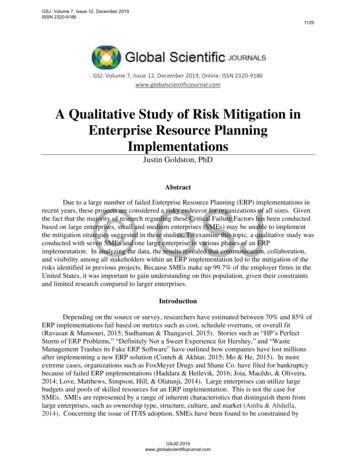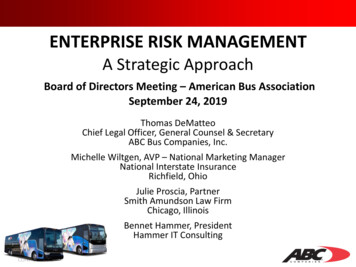
Transcription
ENTERPRISE RISK MANAGEMENTA Strategic ApproachBoard of Directors Meeting – American Bus AssociationSeptember 24, 2019Thomas DeMatteoChief Legal Officer, General Counsel & SecretaryABC Bus Companies, Inc.Michelle Wiltgen, AVP – National Marketing ManagerNational Interstate InsuranceRichfield, OhioJulie Proscia, PartnerSmith Amundson Law FirmChicago, IllinoisBennet Hammer, PresidentHammer IT ConsultingCONFIDENTIAL
What is Enterprise Risk Management?(“ERM”)A strategic analysis of risk throughout anorganization that cuts across businessunits and departments and considers endto end processes.CONFIDENTIAL2
TRADITIONAL (Silo) vs. ERM (Holistic)Examples of Silo Structure: Audit committee on financial risksLegal department on regulatory complianceIT department on technology riskInsurance department on coverage risksSilo Structure May Miss: Cross functional risksIndustry wide risksPolitical risksReputational or brand risksCONFIDENTIAL3
TRENDS PUSHING “ERM” Greater Transparency GenerallyInsurance Carrier RequirementsFinancial DisclosureRating AgenciesGlobalizationSecurity and TechnologyDisaster PreparednessIncreased Regulatory ScrutinyCONFIDENTIAL4
TRENDS PUSHING “ERM” (con’t.)For Example: Wall Street rules require disclosure about acompany’s risk management practices, to include: The board’s role in the oversight of risk and the effect,if any, that this has had on the company’s leadershipstructure. The relationship between a company’s compensationpractices and risk management.CONFIDENTIAL5
WHAT KEEPS YOU UP AT NIGHT?Types of Risk Operational Strategic Financial Compliance LegalCONFIDENTIAL IT/Cyber SecurityReputationalEnvironmentalPolitical
Basic Elements of ERM PlanTo set up an ERM program, a company needs to: Identify the risks faced at all levels of the companyLikelihood of occurrenceQuantify potential impactInterrelationship to each otherDefine risk appetite or toleranceDevelop a framework for managing the risks, with a viewto conforming behavior and decision making within thestated risk appetiteCONFIDENTIAL7
DeterminingRisk Tolerance/AppetiteThe following factors should be considered whensetting risk appetite: Shareholder expectationsWillingness to accept earnings volatilityFinancial capacity to withstand lossWillingness to expand product/service range andgeographical coverage Potential for growth through acquisitions Desired credit rating Risks considered absolutely unacceptableCONFIDENTIAL8
Benefits of ERMEnterprise risk management offers a number ofbenefits: Aligns risk appetite and corporate strategyLinks growth, risk, and returnsImproves risk responsesReduces operational surprises and lossesManages enterprise-wide risksRecognizes and acts upon opportunitiesDeploys resources effectivelyCONFIDENTIAL9
STRATEGIC NEEDSOWNERSHIP BUY-IN WITH RESOURCES CRISIS MANAGEMENT PROGRAM SOPHISTICATED INSURANCE COVERAGECONFIDENTIAL10
Crisis Communications1. The time for decision making isdrastically compressed The dangers of “siloed” organizations aregreatly expanded Demands greater preparation in advanceCONFIDENTIAL
2. The “media” can be anyone, anywhere Social Media – Facebook, Twitter, etc. The BAD NEWS- a vendor, employee, customerANYONE- can write or produce a story The GOOD NEWS- organizations also have morepower to tell their own storiesCONFIDENTIAL
3. Audiences are increasingly sophisticatedand skeptical Everyone has seen this play too many times Incomplete answers, no answers, reluctantanswers and false answers are deadlyCONFIDENTIAL
4. There are no barriers or borders in acrisis The worlds of media, legislation, litigation,regulation, consumer, and financial all overlap Geography is increasingly less important- aproblem in one market is a problem in everymarketCONFIDENTIAL
5. Damaged reputations can berestored more quickly than before With the right focus and resources And with real transparency and candorCONFIDENTIAL
How Many Devices are Connected tothe “Internet of Things”?CONFIDENTIAL
The Internet of Things refers to the rapidlygrowing network of connected objects thatare able to collect and exchange data usingembedded sensors. Gartner Analytics estimates 26 billiondevices in 2020, growing to 100 billionCONFIDENTIAL
Types of Cyber Attacks Phishing (Email Scams)Denial of ServiceMan in MiddleInsider AttackPassword AttackCONFIDENTIAL Injection AttackCross Sites AttackEavesdroppingMalware
Key QuestionsGo home and ask yourself do you have Personal Identifiable Information (PII) onyour system?Definition of PII as follows: An individual’s first name or first initial and lastname in combination with any one or more of the following data elements: Social security numberDriver’s license or state issued identification card numberAccount number, credit card number or debit card number in combination with any requiredsecurity code, access code, or password that would permit access to an individual’s financialaccountMedical information (any information regarding an individual’s medical history, mental orphysical condition, or medical treatment or diagnosis by a health care professional)Health insurance information (an individual’s health insurance policy number or subscriberidentification number, and unique identifier used by a health insurer to identify the individual,or any information in an individual’s application and claims history, including any appealsrecords); orInformation or data collected through the use or operation of an automated license platerecognition system (a searchable computerized database resulting from the operation of one ormore mobile or fixed cameras combined with computer algorithms to read and convert imagesof registration plates and the characters they contain into computer-readable data).CONFIDENTIAL
Cyber Security Key TakeawaysHigh Risk to Companies and Customers Corporate reputation/liability; aggressive enforcement climate Customer privacy – core public policy focus in US and EUBroad Oversight Critical Management focus and resource allocation Robust Enterprise Risk Management (ERM) program, internal controlsand testing Consider Cyber Insurance Policy Regular (at least semi-annual) updates to BoardWhen an Event Occurs Management must undertake immediate and reasonable effort tounderstand facts Disclose to Board and affected stakeholders ASAP Compliance with laws and regulations and every state likely has nuancesCONFIDENTIAL
Types of Commercial Insurance(Spreading of Risk) PropertyGeneral LiabilityAutoIncomeWorkers' CompensationEmployment PracticesCrimeCONFIDENTIAL Cyber Security InsuranceProfessional LiabilityOcean/Inland MarineEquipment BreakdownDirectors and OfficersDifference in ConditionsUmbrellaM&A Insurance
Insurance and Risk Financing Options Traditional InsuranceDeductible ProgramsSelf InsuranceCaptivesRisk Retention GroupsCONFIDENTIAL22
Benefits of Insurance Protects net worth of Business and Owners Reduces financial uncertainty Provides access to claims administration andsafety services Satisfies legal and regulatory requirements Easy to access FlexibleCONFIDENTIAL23
Enterprise Risk ManagementProtecting Your Company
Meet The Presenter Michelle Wiltgen AVP & National Marketing Manager National Interstate Insurance Company –the leading provider of insurance to thePassenger Transportation Industry In the business for 35 years – 28 of them inpassenger transportation Holds a BA in Management & LaborRelations from CSU
Topics for today Current insurance marketplace How did we get here? How can you protect yourcompany? What can you do?
Current MarketplaceINSURANCE SEGMENT REPORT – MIDYEAR 2019Outlook - Continued elevated loss and combined ratios, driven byadverse loss frequency and severity trends and unfavorable prioryear reserve development.
Current MarketplaceRates - Commercial auto insurers continue to raise rates inresponse to the adverse loss frequency and loss severity trends
Current MarketplaceUnderwriting results - The commercial auto combined ratio wasan estimated 110.4% in 2018. This was the eighth consecutiveyear with a combined ratio above 100%.
The top 50Only THREE of the top 50 commercial autoliability insurers have a combined ratio under100:* Progressive Insurance (1): Chubb (8): Great American (19):* Information obtained from Conning Insurance Segment Report - Mid-Year 201985.792.090.7
Loss FrequencyLoss frequency is rising due to: Higher vehicle utilization Distracted driving Deteriorating road conditions Poorer driver profile - companies are hiring lessexperienced/less qualified drivers causing moreaccidents
Loss Severity Loss severity - and “frequency of severity” continue to be amongthe most pressing concerns for commercial auto insurers. Numerous seven and eight figure court awards have fed plaintiffattorney interest in pursuing accident litigation. Increased attorney advertising and growth in litigation funding havealso contributed to the rising loss severity trend. Adverse development: In 2018, the industry experienced 1.8billion of adverse development for commercial auto/truckmedical. ** Information obtained from Conning Insurance Segment Report - Mid-Year 2019
Underwriting Outlook The outlook for commercial auto is for continued poorunderwriting results from adverse loss trends. Adverse trends are driving insurers to take underwritingactions including:- Re-underwriting- Nonrenewal of underperforming policies or segments Industry reports indicate that challenging commercial autoclasses include trucking for hire, tow trucks, nonemergencymedical transportation, and charter buses
Protecting your companyChoose “best in class” partners: Broker/Agent “A” Rated by A.M. Best InsuranceCompanies Insurance coverage/limits to protect yourbusiness
Choose your broker/agent wisely What is their motivation? Are they a broker or an agent?How are they paid, how much, and by whom?What markets do they represent?What is their relationship with those markets?Do they find you a new insurance company every year?Do YOU know who the insurance company is?Do they challenge your decisions? Are you willing to letthem?
Choose your insurer(s) wisely All insurance companies are not equal: Underwriting & Claims expertise and philosophy Commitment to the industry Coverage and service options that fit your business modeland appetite for risk You may need to work with more than one producer to getaccess to all desired insurance markets Financial rating Stability Reputation
A.M. Best AM Best was founded in 1899 by Alfred M. Best withthe mission to report on the financial stability ofinsurers and the insurance industry. It is the oldestand most widely recognized provider of ratings,financial data and news with an exclusive insuranceindustry focus. Best's Credit Ratings, which are issued through A.M.Best Rating Services, Inc., are a recognized indicatorof insurer financial strength and creditworthiness.
A.M. Best How many insurance companies are there in the UnitedStates? Rating Categories: SuperiorA or A Excellent A or A GoodB or B FairB or B Marginal C or C WeakC or C PoorD
A.M. Best How many insurance companies are rated:A or better:27%A or better:65%A- or better:92% Do you know what rating(s) your insurers have?
Coverages/Limits How much insurance is REQUIRED vs. what you NEEDto protect your company? How much insurance is enough? Flood insurance – do you have it? do you need it? Is your total fleet value over 1mil? Excess physical damage Do you use computers? Cyber liability
Do your homework Know what’s covered Punitive Damage Claims “Nuclear verdicts” Punish the wrongdoer Some states do not allow insurancepolicies to cover; some policies mayexclude Could you be negligent in managingsafety?
Risk Financing Options Traditional Insurance First Dollar Deductible Alternative Risk Financing Captives – Group or Single Cell Self Insurance
What can you do? Treat your broker/agent like theconsultant/business partner that they are Meet regularly Not just at renewal time Request/require regular claims reviews With your broker and insurer
Be prepared, start early Quality insurers want the same information everyyear – manage it Your renewal discussion should be 90 days prior toyour effective date, not 9 days Your renewal application should be submitted 60days prior to your effective date, not 6 days You own your loss runs – don’t tolerate delays orgamesmanship
Own your information Review your info to confirm accuracy Correct items that need updating Are the unit counts correct? Are your vehicle values current? Do your IFTA’s match your application? Provide a summary of your business history and futureplans Does your website match your submission info? Do you have a copy of what is submitted on your behalf?
The absence of accidentsis not the presence of safety Proactive Safety Tools & Resources Sufficient safety staffing Discipline and coaching protocols AERs PATs Return to Work Programs Industry Involvement Associations Reputation CSA Scores – fluctuation, alerts, safety rating, etc
Tell us your story Insurance Submissions – Paint the picture Complete info Accurate info Include business growth/future plans Lower confidence in the information can drive uppremiums or be the grounds for declination
One size does not fit all Know the insurers Know the options available Coverages Risk management services Claims service/philosophy
Questions?Michelle WiltgenO: 800-929-1500 x1213M: 440-821-1961Michelle.Wiltgen@natl.comwww.natl.com
Hot Topics inEmployment LawAmerican Bus AssociationSeptember 24, 2019Julie A. ProsciaSmithAmundsen LLC3815 East Main StreetSuite A-1St. Charles, IL 60174Phone: (630) 587-7911jproscia@salawus.comwww.salawus.com
EEOC Trends
Social Media in theWorkplace
Social Media in the Workplace Private Sector employers can: Create a social media policy that sets expectations for how employees shoulduse social media.Monitor work computer use for internet use.Private Sector employers cannot: In most states, employers cannot ask for your password and username tosocial media accounts. 20 states have enacted legislation prohibiting this. Sofar, there is no federal law that prohibits it.In some states, like Michigan and Illinois, employers cannot gather or keepinformation of an employee’s communications or non-employment activities,without the employee consent (with few exceptions).Fire an employee for social networking and social media usage if it is“concerted activity” for the purpose of collective bargaining, mutual aid orprotection.
To Friend or Not to Friend Generally, managers should NOT friend otheremployees on social media. Sending a friend request puts an employee in anuncomfortable position. You will have access to sensitive information. Can see employees posts about political views, religion,lifestyle preferences, medical or health issues. Opens the door to discrimination or harassment. Can add to your professional responsibilities. Most social media posts are too personal for work.
Social Media in the Workplace Employers can screen candidates’ public socialmedia accounts, BUT comes with consequences: Cannot have an employee “friend” or “follow” acandidate to view their private account. 70% of employers screen candidates’ social mediaaccounts during the hiring process. Potential danger in unknowingly collecting protectedinformation like age, skin color, race, gender, religion,etc. This can create a bias or discrimination problem.
Social Media in the Workplace Can Employers fire an employee for social mediaposts? Most employees are “at-will” employees, employer canterminate for any reason that is not illegal or in violation ofa contract. But, not always a good idea to terminate based on socialmedia posts. Each situation needs to be considered on acase-by-case basis. Posts about company information or negative comments aboutyour job/clients will tend to be grounds for termination. Potential to violate state and federal laws for firing anemployee due to off-duty social media posts.
Trends of Ageism Age based EEOC complaints are rising steadily due to the continuedincrease of older workers in the job force. More baby boomers are staying in the workforce longer due to theRecession that left many unemployed or depleted their retirementsavings.In 2017, 18,376 age discrimination complaints were filed with theEEOC. Age based harassment claims have tripled in 2017 compared to1992. Job postings may tend to prefer young workers who are “digitalnatives” and familiar with technologySignificant jump in age based discrimination charges in 2010 datadue to the Recession.
Trends of AgeismADEA Charges Alleging Age and Race, Age and Sex, Age and DisabilityDiscrimination
#MeToo National Trends
#MeToo Timeline“If you have beensexually harassedor assaulted, write#MeToo and replyto this Tweet”-Alyssa MilanoJust BeMe Inc.Judge rules infavor of TaylorSwift199720062016Aug.2017Oct. 52017HarveyWeinstein(42 women)TaranaBurkeAccessHollywoodTapeOct. 152017Oct. 182017McKaylaMaroney –LarryNassar(265)KavanaughHearings –Dr. BlaseyFordBill swalkout rkerswalk outin protest2019
#MeToo National Trends Recent statistics from the EEOC Sexual harassment charges with the EEOC increased byover 12% from the previous calendar year; the firstincrease in harassment complaints in a decade. Sexual harassment lawsuits filed by the EEOC increased by50% since 2017. The total recovery for sexual harassment complainantsrose from 47.5 million in 2017 to approximately 70million in 2018. In the last year, website traffic to the EEOC’s sexualharassment page more than doubled.
#MeToo National Trends Movement to individual liability, i.e. Californiaand Illinois.Movement to direct access to court.Movement to mandated training.Changes in the perception of what is and is notreasonable workplace behavior.
What States Have Done IL: Requires harassment trainings for all employees, limits theuse of policies or agreements intended to prevent employeesfrom reporting sexual harassment, made harassment againstcontract workers illegal, prohibits union representatives fromrepresenting both a victim of sexual harassment and theharasser.NY: The new law lowers the burden of proof for harassmentclaims. Any harassment based on a protected class, or forparticipating in protected activity, will be unlawful “regardlessof whether such harassment would be considered severe orpervasive under precedent applied to harassment claims.”
What States Have Done TN: Prohibits employers from requiring employees and job applicantsto sign non-disclosure agreements about sexual harassment as acondition of employment.OR: Significantly increased the statute of limitations within which anaggrieved employee may file a lawsuit or administrative claim alleging,among other things, discrimination on the basis of race, color, religion,sex, sexual orientation, national origin, marital status, age, uniformedservice, or disability.VT: A new law prohibits businesses from requiring employees to signaway their right to report or sue for sexual harassment, and prohibitssettlement agreements from including provisions that say theemployee cannot work for the business in the future.
States with Mandatory HarassmentTraining California: Currently, companies with 50 or more employees must provide 2hours of training every 2 years for supervisory employees. Newsupervisory employees, upon assumption of position, must betrained within 6 months. Employers can keep supervisors on theirindi
Sep 24, 2019 · ENTERPRISE RISK MANAGEMENT A Strategic Approach Thomas DeMatteo Chief Legal Officer, General Counsel & Secretary ABC Bus Companies, Inc. Michelle Wiltgen, AVP –National Marketing Manager National Interstate Insurance Richfield, Ohio Julie Proscia, Partner Smith Amundson Law Firm Chicag
